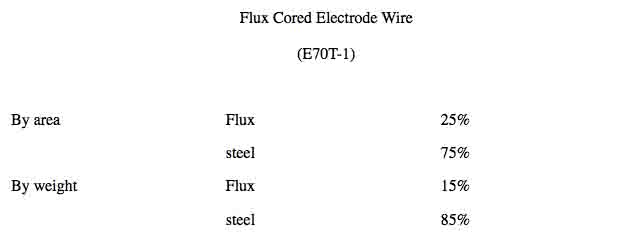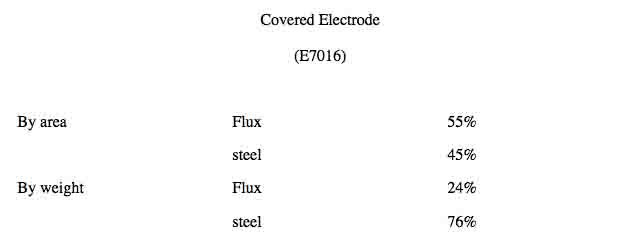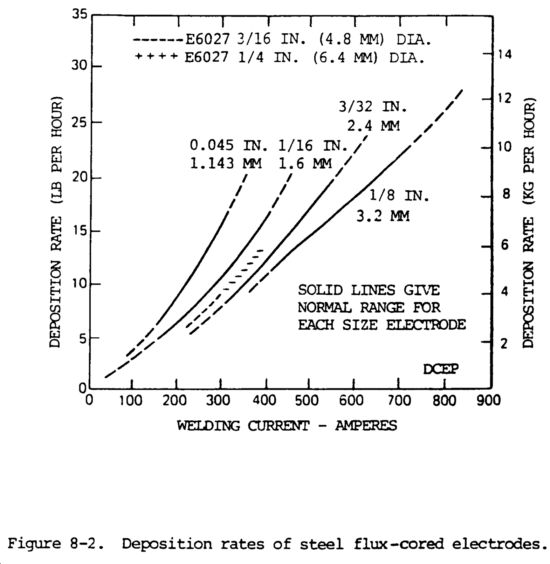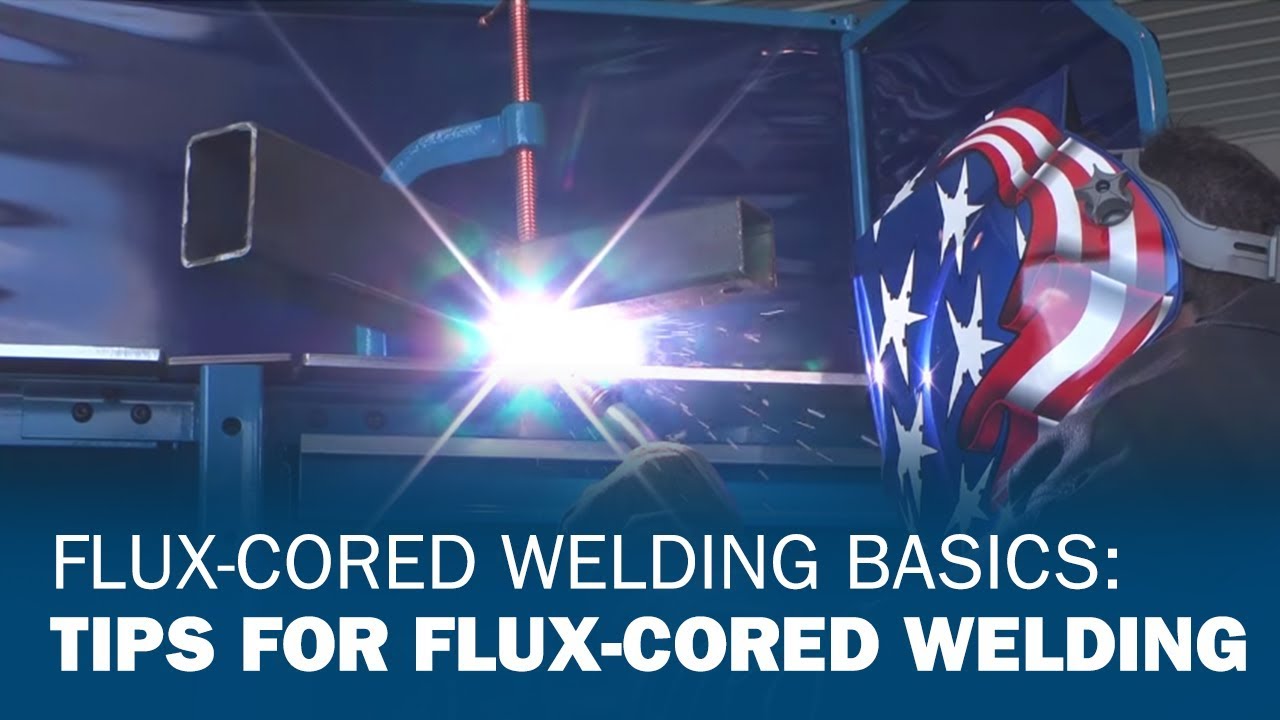The flux-cored arc welding process (FCAW or FCA) is made possible by the design of the electrode.
This inside-outside electrode consists of a metal sheath surrounding a core of fluxing and alloying compounds.
The compounds contained in the electrode perform essentially the same functions as the coating on a covered electrode, i.e., deoxidizers, slag formers, arc stabilizers, alloying elements, and may provide shielding gas.
There are three reasons why flux-cored welding wires are developed to supplement solid electrode wires of the same or similar analysis.
- There is an economic advantage. Solid wires are drawn from steel billets of the specified analyses. These billets are not readily available and are expensive. A single billet might also provide more solid electrode wire than needed. In the case of cored wires, the special alloying elements are introduced in the core material to provide the proper deposit analysis.
- The tubular wire production method provides the versatility of composition and is not limited to the analysis of available steel billets.
- Tubular electrode wires are easier for the flux core welder to use than solid wires of the same deposit analysis, especially for welding pipe in the fixed position.
Flux Cored Welding Basics Video
Flux-Cored Electrode Design

The sheath or steel portion of the flux-cored wire comprises 75 to 90 percent of the weight of the electrode, and the core material represents 10 to 25 percent of the weight of the electrode.
For a covered electrode, the steel represents 75 percent of the weight and the flux 25 percent. This is shown in more detail below:

More flux is used on covered electrodes than in a flux-cored wire to do the same job. This is because the covered electrode coating contains binders to keep the coating intact and agents that allow the coating to be extruded.
Read more: What does flux do in welding?
Self-Shielding Flux-Cored Electrodes
The self-shielding type flux-cored electrode wires include additional gas-forming elements in the core. These are necessary to prohibit the oxygen and nitrogen of the air from contacting the metal transferring across the arc and the molten weld puddle.
Self-shielding electrodes also include extra deoxidizing and denigrating elements to compensate for oxygen and nitrogen, which may contact the molten metal. Self-shielding electrodes are usually more voltage-sensitive and require an electrical stick out for a smooth operation. The properties of the weld metal deposited by the self-shielding wires are sometimes inferior to those produced by the externally shielded electrode wires because of the extra amount of deoxidizers included.
It is possible for these elements to build up in multipass welds, lower the ductility, and reduce the impact values of the deposit. Some codes prohibit the use of self-shielding wires on steels with yield strength exceeding 42,000 psi (289,590 kPa). Other codes prohibit the self-shielding wires from being used on dynamically loaded structures.
Metal Transfer
Metal transfer from consumable electrodes across an arc has been classified into three general modes. These are:
- Spray transfer
- Globular transfer
- Short-circuiting transfer
The metal transfer of flux-cored electrodes resembles a fine globular transfer. On cored electrodes in a carbon dioxide shielding atmosphere, the molten droplets build up around the outer sheath of the electrode. The core material appears to transfer independently to the surface of the weld puddle.
At low currents, the droplets tend to be larger than when the current density is increased. The transfer is more frequent with smaller drops when the current is increased. The larger droplets at the lower currents cause a certain amount of splashing action when they enter the weld puddle. This action decreases with the smaller droplet size.
This explains why there is less visible spatter, the arc appears smoother to the welder, and the deposition efficiency is higher when the electrode is used at a high current rather than at the low end of its current range.
Read more: Metal Transfer Methods
Mild Steel Electrodes
Carbon steel electrodes are classified by the American Welding Society specification, “Carbon Steel Electrodes for Flux-cored-Arc Welding”. This specification includes electrodes having no appreciable alloy content for welding mild and low alloy steels.
The system for identifying flux-cored electrodes follows the same pattern as electrodes for gas metal arc welding, but is specific for tubular electrodes. For example, in E70T-1, the E indicates an electrode; 70 indicates the required minimum as-welded tensile strength in thousands of pounds per square inch (psi); T indicates tubular, fabricated, or flux-cored electrode; and 1 indicates the chemistry of the deposited weld metal, gas type, and usability factor.
Classification of Flux-Cored Electrodes
- E60T-7 electrode classification. Electrodes of this classification are used without externally applied gas shielding and may be used for single-and multiple-pass applications in the flat and horizontal positions. Due to low penetration and to other properties, the weld deposits have a low sensitivity to cracking.
- E60T-8 electrode classifications. Electrodes of this classification are used without externally applied gas shielding and may be used for single-and multiple-pass applications in the flat and horizontal positions. Due to low penetration and to other properties, the weld deposits have a low sensitivity to cracking.
- E70T-1 electrode classification. Electrodes of this classification are designed to be used with carbon dioxide shielding gas for single-and multiple-pass welding in the flat position and for horizontal fillets. A quiet arc, high-deposition rate, low spatter loss, flat-to-slightly convex bead configuration, and easily controlled and removed slag are characteristics of this class.
- E70T-2 electrode classification. Electrodes of this classification are used with carbon dioxide shielding gas and are designed primarily for single-pass welding in the flat position and for horizontal fillets. However, multiple-pass welds can be made when the weld beads are heavy and an appreciable amount of mixture of the base and filler metals occurs.
- E70T-3 electrode classification. Electrodes of this classification are used without externally applied gas shielding and are intended primarily for depositing single-pass, high-speed welds in the flat and horizontal positions on light plate and gauge thickness base metals. They should not be used on heavy sections or for multiple-pass applications.
- E70T-4 electrode classification. Electrodes of this classification are used without externally applied gas shielding and may be used for single-and multiple-pass applications in the flat and horizontal positions. Due to low penetration, and to other properties, the weld deposits have a low sensitivity to cracking.
- E70T-5 electrode classification. This classification covers electrodes primarily designed for flat fillet or groove welds with or without externally applied shielding gas. Welds made using-carbon dioxide shielding gas have better quality than those made with no shielding gas. These electrodes have a globular transfer, low penetration, slightly convex bead configuration, and a thin easily removed slag.
- E70T-6 electrode classification. Electrodes of this classification are similar to those of the E70T-5 classification but are designed for use without an externally applied shielding gas
- E70T-G electrode classification. This classification includes those composite electrodes that are not included in the preceding classes. They may be used with or without gas shielding and may be used for multiple-pass work or may be limited to single-pass applications. The E70T-G electrodes are not required to meet the chemical, radiographic, bend test, or impact requirements; however, they are required to meet tension test requirements. Welding current type is not specified.
The flux-cored electrode wires are considered to be low hydrogen since the materials used in the core do not contain hydrogen. However, some of these materials are hygroscopic and thus tend to absorb moisture when exposed to a high-humidity atmosphere.
Electrode wires are packaged in special containers to prevent this. These electrode wires must be stored in a dry room.
Also read: .030 vs .035 flux core wire
Stainless Steel Tubular Wires
Flux-cored tubular electrode wires are available, which deposit stainless steel weld metal corresponding to the A.I.S.I. compositions.
These electrodes are covered by the A.W.S specification, “Flux-Cored Corrosion Resisting Chromium and Chromium-Nickel Steel Electrodes.”
These electrodes are identified by the prefix E followed by the standard A.I.S.I. code number.
This is followed by the letter T indicating a tubular electrode. Following this and a dash are four-possible suffixes as follows:
- 1 indicates the use of C02 (carbon dioxide) gas for shielding and DCEP.
- 2 indicates the use of argon plus 2 percent oxygen for shielding and DCEP.
- 3 indicates no external gas shielding and DCEP.
- G indicates that gas shielding and polarity are not specified.
Tubular or flux-cored electrode wires are also used for surfacing and submerged arc welding applications.
Related: Can You Weld Stainless Steel With Flux Core Without Gas?
Deposition Rates and Weld Quality
The deposition rates for flux-cored electrodes are shown in figure 8-2 below. These curves show deposition rates when welding with mild and low-alloy steel using direct current electrode positive.
Two types of covered electrodes are shown for comparison. Deposition rates of the smaller size flux-cored wires exceed that of the covered electrodes.
The metal utilization of the flux-cored electrode is higher. Flux-cored electrodes have a much broader current range than covered electrodes, which increases the flexibility of the process.
The quality of the deposited weld metal produced by the flux-cored arc welding process depends primarily on the flux-cored electrode wire that is used. It can be expected that the deposited weld metal will match or exceed the properties shown for the electrode used.
This assures the proper matching of base metal, flux-cored electrode type and shielding gas.
Quality depends on the efficiency of the gas shielding envelope, on the joint detail, on the cleanliness of the joint, and on the skill of the welder.
The quality level of weld metal deposited by the self-shielding type electrode wires is usually lower than that produced by electrodes that utilize external gas shielding.

